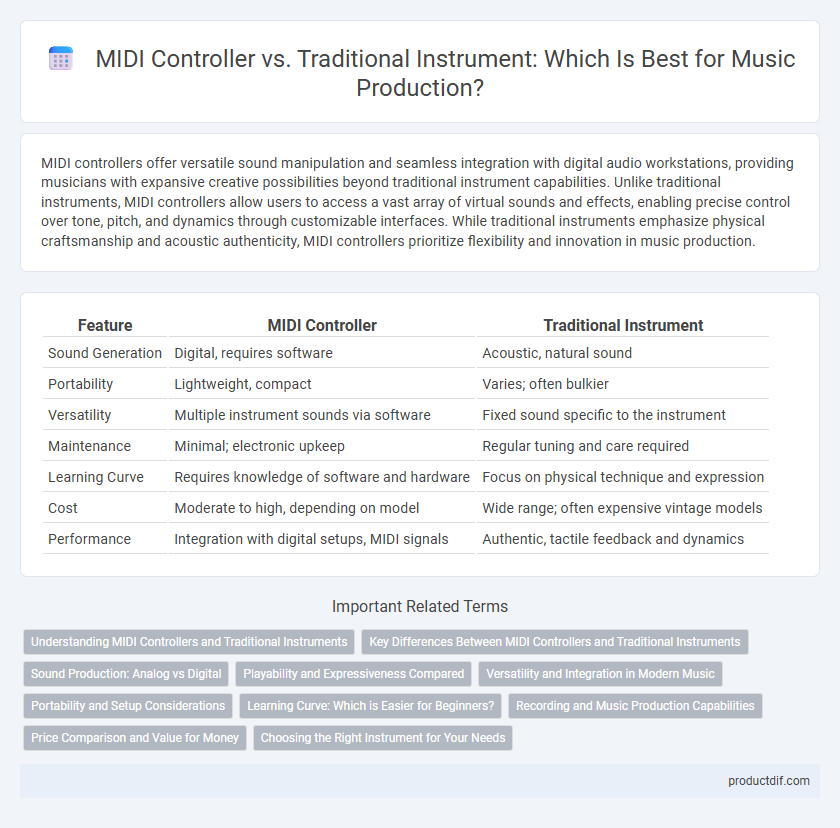MIDI controllers offer versatile sound manipulation and seamless integration with digital audio workstations, providing musicians with expansive creative possibilities beyond traditional instrument capabilities. Unlike traditional instruments, MIDI controllers allow users to access a vast array of virtual sounds and effects, enabling precise control over tone, pitch, and dynamics through customizable interfaces. While traditional instruments emphasize physical craftsmanship and acoustic authenticity, MIDI controllers prioritize flexibility and innovation in music production.
Table of Comparison
| Feature | MIDI Controller | Traditional Instrument |
|---|---|---|
| Sound Generation | Digital, requires software | Acoustic, natural sound |
| Portability | Lightweight, compact | Varies; often bulkier |
| Versatility | Multiple instrument sounds via software | Fixed sound specific to the instrument |
| Maintenance | Minimal; electronic upkeep | Regular tuning and care required |
| Learning Curve | Requires knowledge of software and hardware | Focus on physical technique and expression |
| Cost | Moderate to high, depending on model | Wide range; often expensive vintage models |
| Performance | Integration with digital setups, MIDI signals | Authentic, tactile feedback and dynamics |
Understanding MIDI Controllers and Traditional Instruments
MIDI controllers are electronic devices that send musical performance data to computers or synthesizers, allowing musicians to manipulate digital sounds with precision and versatility. Traditional instruments produce sound acoustically through physical interaction with strings, keys, or air flow, offering a tactile and expressive performance experience rooted in centuries of musical heritage. Understanding the differences in sound generation, control, and flexibility helps musicians choose between the dynamic adaptability of MIDI controllers and the authentic resonance of traditional instruments.
Key Differences Between MIDI Controllers and Traditional Instruments
MIDI controllers transmit digital signals to manipulate sounds rather than producing audio themselves, offering extensive versatility in music production through software integration. Traditional instruments generate acoustic sound directly, providing a tactile and expressive playing experience rooted in physical interaction with strings, keys, or membranes. The key differences lie in sound generation methods, portability, and the reliance on external devices for MIDI controllers compared to the self-contained nature of traditional instruments.
Sound Production: Analog vs Digital
MIDI controllers generate sound digitally by sending electronic signals to synths or software, allowing unlimited sound customization and layering. Traditional instruments produce analog sounds through physical vibration of strings, membranes, or air columns, resulting in rich, natural tones with organic nuances. Digital sound production offers precision and versatility, while analog sound embodies authenticity and tactile interaction.
Playability and Expressiveness Compared
MIDI controllers offer customizable playability with velocity-sensitive pads, programmable knobs, and pitch bends that expand expressive possibilities beyond traditional instruments. Unlike conventional instruments, MIDI controllers can simulate various sounds, allowing musicians to emulate multiple instruments with a single device. However, traditional instruments provide a tactile, nuanced response with natural dynamics and physical feedback that often result in more authentic, expressive performances.
Versatility and Integration in Modern Music
MIDI controllers offer unparalleled versatility by enabling musicians to access a wide range of sounds and effects through software integration, making them essential for modern electronic music production. Traditional instruments provide authentic acoustic tonal qualities but typically lack the adaptability and seamless connectivity with digital audio workstations (DAWs) that MIDI controllers deliver. The integration capability of MIDI controllers with various music production tools allows artists to experiment with complex arrangements and real-time sound manipulation, expanding creative possibilities beyond the limitations of conventional instruments.
Portability and Setup Considerations
MIDI controllers offer exceptional portability due to their compact size and lightweight design, making them ideal for musicians who travel frequently or perform in various locations. Unlike traditional instruments, MIDI controllers require minimal setup, only needing a connection to a computer or sound module, which simplifies the preparation process for live performances or studio sessions. Traditional instruments often demand more space and careful handling, with extended tuning and assembly time, impacting their convenience for on-the-go use.
Learning Curve: Which is Easier for Beginners?
MIDI controllers offer a more intuitive interface with customizable layouts and built-in tutorials, making them accessible for beginners without prior musical experience. Traditional instruments require mastering physical techniques and finger placements, often demanding consistent practice to develop muscle memory. The learning curve for MIDI controllers tends to be shorter due to digital aids, while traditional instruments provide foundational skills essential for advanced musical proficiency.
Recording and Music Production Capabilities
MIDI controllers offer unparalleled flexibility in recording and music production, allowing real-time manipulation of virtual instruments, dynamic control over multiple sound parameters, and seamless integration with digital audio workstations (DAWs). Traditional instruments provide authentic acoustic tones but lack the direct compatibility and programmable features that streamline the production workflow in modern studios. The ability of MIDI controllers to capture precise performance data enhances editing capabilities, making them essential tools for contemporary music creation.
Price Comparison and Value for Money
MIDI controllers generally offer a more affordable entry point compared to traditional instruments, with prices ranging from $100 to $500, while high-quality acoustic or electric instruments often exceed $1,000. The value for money in MIDI controllers is enhanced by their versatility, integrating with multiple software and sound libraries to create a wide range of tones without additional purchases. Traditional instruments provide intrinsic tactile feedback and authentic sound quality, which can justify their higher cost for professional musicians and enthusiasts seeking genuine acoustic performance.
Choosing the Right Instrument for Your Needs
MIDI controllers offer versatile sound customization and seamless integration with digital audio workstations, making them ideal for producers and electronic musicians seeking expansive sonic possibilities. Traditional instruments provide authentic tactile feedback and acoustic resonance, preferred by performers who value organic sound and expressive dynamics. Choosing the right instrument depends on whether your focus is on digital flexibility and production or on the physical interaction and natural tones of conventional instruments.
MIDI Controller vs Traditional Instrument Infographic

 productdif.com
productdif.com